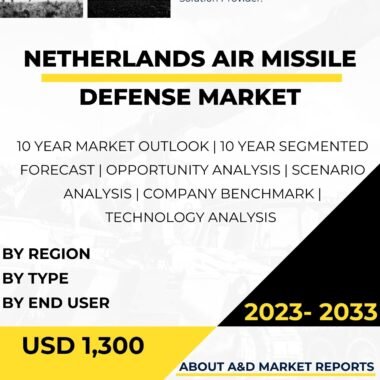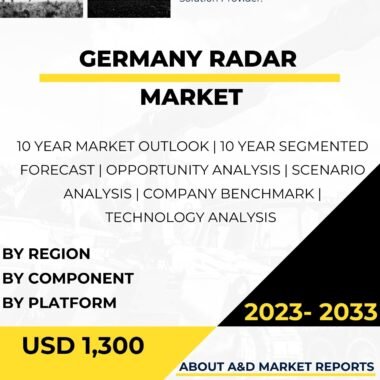Description
The Malaysia antenna, transducer, and radome market have experienced significant growth and interest in recent years as the nation recognizes the importance of advanced communication, sensing, and radar technologies for various applications. Antennas, transducers, and radomes are critical components in a wide range of industries, including defense, telecommunications, aerospace, and automotive sectors.
One of the primary drivers behind the growth of the antenna, transducer, and radome market in Malaysia is the increasing demand for enhanced communication capabilities. As the nation advances in its digital transformation and embraces Industry 4.0 technologies, the need for reliable and efficient communication systems becomes paramount.
In the defense sector, antennas, transducers, and radomes play a crucial role in military communication, radar, electronic warfare, and surveillance systems. Advanced antenna technologies enable secure and seamless communication between military assets, enhancing situational awareness and command capabilities.
Additionally, radar systems equipped with high-performance radomes and transducers provide crucial intelligence for defense operations, including target detection, tracking, and threat identification. The use of advanced materials and manufacturing processes in radome design ensures radar system performance in challenging environments and adverse weather conditions.
The Malaysia Armed Forces’ involvement in regional peacekeeping missions and humanitarian operations further underscores the importance of antenna, transducer, and radome technologies in supporting successful military operations and providing essential situational awareness.
In the telecommunications sector, the rapid growth of mobile and wireless communication services has spurred demand for innovative antennas and transducers. The advent of 5G technology and the increasing use of IoT (Internet of Things) devices require antennas that offer improved bandwidth, coverage, and reliability.
Moreover, as Malaysia invests in smart city initiatives and digital infrastructure, antennas and transducers play a crucial role in enabling reliable data communication and connectivity for various IoT devices and smart applications.
The aerospace industry also represents a significant market for antennas, transducers, and radomes. Malaysia’s position as an emerging aerospace hub necessitates advanced communication and sensing systems for aircraft and unmanned aerial vehicles (UAVs).
Furthermore, antennas and transducers are integral to the automotive industry, supporting various applications such as GPS navigation, satellite radio, and vehicle-to-vehicle communication. The growing demand for connected vehicles and autonomous driving technologies further drives the need for advanced communication solutions in the automotive sector.
As Malaysia seeks to develop indigenous defense capabilities and strengthen its position in high-tech industries, the antenna, transducer, and radome market offer opportunities for local research and development initiatives. Collaborations between the government, academia, and local technology companies, as well as partnerships with international manufacturers, can facilitate technology transfer and expertise development, fostering the growth of Malaysia’s defense and high-tech industries.
Moreover, the expansion of the antenna, transducer, and radome market also presents economic benefits through job creation and attracting foreign direct investment. As the demand for advanced communication and sensing technologies increases, local manufacturing and maintenance facilities can be established, generating employment and enhancing Malaysia’s technological capabilities.
However, several challenges must be addressed to fully realize the potential of the antenna, transducer, and radome market in Malaysia. One significant obstacle is the need for continuous research and development to improve the performance, efficiency, and miniaturization of these components. Advancements in material science, manufacturing processes, and antenna design are essential to meet the ever-increasing demands of diverse industries.
Additionally, ensuring the quality and reliability of antennas, transducers, and radomes is crucial, especially in critical applications like defense and aerospace. Rigorous testing and quality control measures are necessary to meet international standards and customer requirements.
Furthermore, promoting local manufacturing capabilities and enhancing technical expertise in antenna and transducer design will strengthen Malaysia’s position in the global market. Strategic initiatives to build a skilled workforce and foster partnerships with international industry leaders will contribute to Malaysia’s competitiveness in the high-tech industries.
Moreover, ensuring compliance with international regulations and export controls in the defense sector is essential. Adhering to international standards promotes responsible arms trade practices and ensures Malaysia’s standing in the global defense market.
In conclusion, the antenna, transducer, and radome market in Malaysia have experienced significant growth as the nation recognizes the importance of advanced communication and sensing technologies for defense, telecommunications, aerospace, and automotive industries. The adoption of advanced antenna, transducer, and radome technologies enhances communication capabilities, situational awareness, and radar systems’ performance. Efforts to develop indigenous capabilities through research and development initiatives and collaborations with international manufacturers are crucial for sustainable growth in the market. Addressing challenges related to technology advancement, quality, local manufacturing capabilities, and compliance will be essential to ensure the successful integration and use of antennas, transducers, and radomes in Malaysia’s defense, aerospace, and high-tech sectors. By investing in cutting-edge technologies and fostering collaborations between the government, academia, and industry players, Malaysia can enhance its defense capabilities, support high-tech industries, and contribute to national security and economic growth.




